Bandwidth Enhancement and Generation of CP of Yagi-Uda-Shape Feed on a Rectangular DRA for 5G Applications
Abstract
1. Introduction
2. Antenna Design and Analysis
2.1. Antenna Configuration
2.2. Evolution of Wideband RRDA Antenna
2.3. Simulation of Antenna-A Antenna-B Design, Analysis, and Discussion
2.4. Incorporating Parasitic Patch
2.5. Working Principle, Generation of CP, Simulation Results of Design, Analysis, and Discussion
2.6. Parasitic Strip Optimization
3. Simulated Result of the Proposed Antenna
4. Measured Results and Discussion
5. Conclusions
Author Contributions
Funding
Data Availability Statement
Acknowledgments
Conflicts of Interest
References
- Illahi, U.; Iqbal, J.; Sulaiman, M.I.; Alam, M.; Mazliham, M.S. A novel singly fed wideband circularly polarized cylindrical multilayer DRA using Flat surface hook-shaped metal strip. In Proceedings of the 2017 International Conference on Engineering Technology and Technopreneurship (ICE2T), Kuala Lumpur, Malaysia, 18–20 September 2017; pp. 1–4. [Google Scholar] [CrossRef]
- Iqbal, J.; Illahi, U.; Sulaiman, M.I.; Alam, M.; Mazliham, M.S. Bandwidth Enhancement of Rectangular Dielectric Resonator Antenna with and Without a Parasitic Patch. J. Eng. Technol. 2017, 5, 5–8. [Google Scholar]
- Saqlain, M.; Mohammadi, A.M.; Kamal, S.; Ehsan, A. Self Phase Modulation Effects on Dispersion Compensated Tributary Mapping Multiplexing Transmission. Sci. Int. 2014, 26, 1083–1087. [Google Scholar]
- Zambak, M.F.; Yasin, M.N.M.; Adam, I.; Iqbal, J.; Osman, M.N. Higher-Order-Mode Triple Band Circularly Polarized Rectangular Dielectric Resonator Antenna. Appl. Sci. 2021, 11, 3493. [Google Scholar] [CrossRef]
- Munir, M.E.; Al Harbi, A.G.; Kiani, S.H.; Marey, M.; Parchin, N.O.; Khan, J.; Mostafa, H.; Iqbal, J.; Khan, M.A.; See, C.H.; et al. A New mm-Wave Antenna Array with Wideband Characteristics for Next Generation Communication Systems. Electronics 2022, 11, 1560. [Google Scholar] [CrossRef]
- Iqbal, J.; Illahi, U.; Yasin, M.N.M.; Albreem, M.A.; Akbar, M.F. Bandwidth enhancement by using parasitic patch on dielectric resonator antenna for sub-6 GHz 5G NR bands application. Alex. Eng. J. 2022, 61, 5021–5032. [Google Scholar] [CrossRef]
- Illahi, U.; Iqbal, J.; Irfan, M.; Ismail Sulaiman, M.; Khan, M.A.; Rauf, A.; Bari, I.; Abdullah, M.; Muhammad, F.; Nowakowski, G.; et al. A Novel Design and Development of a Strip-Fed Circularly Polarized Rectangular Dielectric Resonator Antenna for 5G NR Sub-6 GHz Band Applications. Sensors 2022, 22, 5531. [Google Scholar] [CrossRef] [PubMed]
- Ali, A.; Tong, J.; Iqbal, J.; Illahi, U.; Rauf, A.; Rehman, S.U.; Ali, H.; Qadir, M.M.; Khan, M.A.; Ghoniem, R.M. Mutual Coupling Reduction through Defected Ground Structure in Circularly Polarized, Dielectric Resonator-Based MIMO Antennas for Sub-6 GHz 5G Applications. Micromachines 2022, 13, 1082. [Google Scholar] [CrossRef]
- Ghaffar, A.; Li, X.J.; Awan, W.A.; Iffat Naqvi, S.; Hussain, N.; Seet, B.-C.; Alibakhshikenari, M.; Falcone, F.; Limiti, E. Design and Realization of a Frequency Reconfigurable Multimode Antenna for ISM, 5G-Sub-6-GHz, and S-Band Applications. Appl. Sci. 2021, 11, 1635. [Google Scholar] [CrossRef]
- Awan, W.A.; Naqvi, S.I.; Ali, W.A.E.; Hussain, N.; Iqbal, A.; Tran, H.H.; Alibakhshikenari, M.; Limiti, E. Design and Realization of a Frequency Reconfigurable Antenna with Wide, Dual, and Single-Band Operations for Compact Sized Wireless Applications. Electronics 2021, 10, 1321. [Google Scholar] [CrossRef]
- Bayarzaya, B.; Hussain, N.; Awan, W.A.; Sufian, M.A.; Abbas, A.; Choi, D.; Lee, J.; Kim, N. A Compact MIMO Antenna with Improved Isolation for ISM, Sub-6 GHz, and WLAN Application. Micromachines 2022, 13, 1355. [Google Scholar] [CrossRef]
- Iqbal, J.; Illahi, U.; Khan, M.A.; Rauf, A.; Ali, E.M.; Bari, I.; Ali, H.; Khan, M.A.; Alibakhshikenari, M.; Dalarsson, M. A Novel Single-Fed Dual-Band Dual-Circularly Polarized Dielectric Resonator Antenna for 5G Sub-6GHz Applications. Appl. Sci. 2022, 12, 5222. [Google Scholar] [CrossRef]
- Jiang, Z.; Zhang, F. Single Feed Broadband Circularly Polarized Antenna with Parasitic Patch. In Proceedings of the 2018 12th International Symposium on Antennas, Propagation and EM Theory (ISAPE), Hangzhou, China, 3–6 December 2018; pp. 1–3. [Google Scholar] [CrossRef]
- Nikkhah, A.; Oraizi, H. Efficient 2 × 2 printed circuit band-gap cavity-backed slot antenna. IEEE Trans. Antennas Propag. 2020, 68, 2550–2556. [Google Scholar] [CrossRef]
- Xu, H.; Chen, Z.; Liu, H.; Chang, L.; Huang, T.; Ye, S.; Zhang, L.; Du, C. Single-Fed Dual-Circularly Polarized Stacked Dielectric Resonator Antenna for K/Ka-Band UAV Satellite Communications. IEEE Trans. Veh. Technol. 2022, 71, 4449–4453. [Google Scholar] [CrossRef]
- Rappaport, T.S.; Xing, Y.; MacCartney, G.R.; Molisch, A.F.; Mellios, E.; Zhang, J. Overview of millimeter wave communications for fifthgeneration (5G) wireless networks—With a focus on propagation models. IEEE Trans. Antennas Propag. 2017, 65, 6213–6230. [Google Scholar] [CrossRef]
- Mao, C.-X.; Khalily, M.; Xiao, P.; Brown, T.W.C.; Gao, S. Planar Sub-Millimeter-Wave Array Antenna with Enhanced Gain and Reduced Sidelobes for 5G Broadcast Applications. IEEE Trans. Antennas Propag. 2019, 67, 160–168. [Google Scholar] [CrossRef]
- Yao, Y.; Cheng, X.; Wang, C.; Yu, J.; Chen, X. Wideband Circularly Polarized Antipodal Curvedly Tapered Slot Antenna Array for 5G Applications. IEEE J. Sel. Areas Commun. 2017, 35, 1539–1549. [Google Scholar] [CrossRef]
- Yang, Y.-H.; Shao, C.; Zhang, H.-F.; Wang, Z.-Y.; Zhou, S.-G. A Wideband Endfire Dual Circularly Polarized Antenna for 5G Millimeter-Wave Applications. IEEE Antennas Wirel. Propag. Lett. 2022, 21, 2000–2004. [Google Scholar] [CrossRef]
- Cheng, Y.; Dong, Y. Wideband Circularly Polarized Planar Antenna Array for 5G Millimeter-Wave Applications. IEEE Trans. Antennas Propag. 2021, 69, 2615–2627. [Google Scholar] [CrossRef]
- Liu, S.; Wang, Z.; Dong, Y. Compact Wideband SRR-Inspired Antennas for 5G Microcell Applications. IEEE Trans. Antennas Propag. 2021, 69, 5998–6003. [Google Scholar] [CrossRef]
- Wu, Q.; Hirokawa, J.; Yin, J.; Yu, C.; Wang, H.; Hong, W. Millimeter-Wave Multibeam Endfire Dual-Circularly Polarized Antenna Array for 5G Wireless Applications. IEEE Trans. Antennas Propag. 2018, 66, 4930–4935. [Google Scholar] [CrossRef]
- Zeng, J.; Luk, K.-M. Single-Layered Broadband Magnetoelectric Dipole Antenna for New 5G Application. IEEE Antennas Wirel. Propag. Lett. 2019, 18, 911–915. [Google Scholar] [CrossRef]
- Luk, K.M.; Leung, K.W. (Eds.) Dielectric Resonator Antennas; Research Studies Press: London, UK, 2003. [Google Scholar]
- CST. Reference Manual; CST: Darmstadt, Germany, 2017. [Google Scholar]
- Counselman, C.C. Multipath-rejecting GPS antennas. Proc. IEEE 1999, 87, 86–91. [Google Scholar] [CrossRef]
- Perron, A.; Denidni, T.A.; Sebak, A.R. Circularly polarized microstrip/elliptical dielectric ring resonator antenna for millimeter-wave applications. IEEE Antennas Wireless Propag. Lett. 2010, 9, 783–786. [Google Scholar] [CrossRef]
- Akbari, M.; Gupta, S.; Farahani, M.; Sebak, A.R.; Denidni, T.A. Gain enhancement of circularly polarized dielectric resonator antenna based on FSS superstrate for MMW applications. IEEE Trans. Antennas Propag. 2016, 64, 5542–5546. [Google Scholar] [CrossRef]
- Lai, Q.; Fumeaux, C.; Hong, W.; Vahldieck, R. 60 GHz aperturecoupled dielectric resonator antennas fed by a half-mode substrate integrated waveguide. IEEE Trans. Antennas Propag. 2010, 58, 1856–1864. [Google Scholar]
- Fakhte, S.; Oraizi, H.; Matekovits, L. Gain improvement of rectangular dielectric resonator antenna by engraving grooves on its side walls. IEEE Antennas Wirel. Propag. Lett. 2017, 16, 2167–2170. [Google Scholar] [CrossRef]
- Fakhte, S.; Oraizi, H.; Matekovits, L. High gain rectangular dielectric resonator antenna using uniaxial material at fundamental mode. IEEE Trans. Antennas Propag. 2017, 65, 342–347. [Google Scholar] [CrossRef]
- Sun, W.; Yang, W.; Chu, P.; Chen, J. Design of a wideband circularl polarized stacked dielectric resonator antenna. IEEE Trans. Antennas Propag. 2019, 67, 591–595. [Google Scholar] [CrossRef]
- Yang, W.; Dong, X.; Li, Y.; Chen, J. A self-packaged circularl polarized dielectric resonator antenna with wide bandwidth and high gain. IEEE Antennas Wireless Propag. Lett. 2018, 17, 2188–2192. [Google Scholar] [CrossRef]
- Nikkhah, A.; Oraizi, H. Implementation of Parasitic DRA Elements for Improvement of Circular Polarization. IEEE Antennas Wirel. Propag. Lett. 2021, 20, 2387–2391. [Google Scholar] [CrossRef]
- Mongia, R.K.; Ittipiboon, A. Theoretical and experimental investigations on rectangular dielectric resonator antennas. IEEE Trans. Antennas Propag. 1997, 45, 1348–1356. [Google Scholar] [CrossRef]
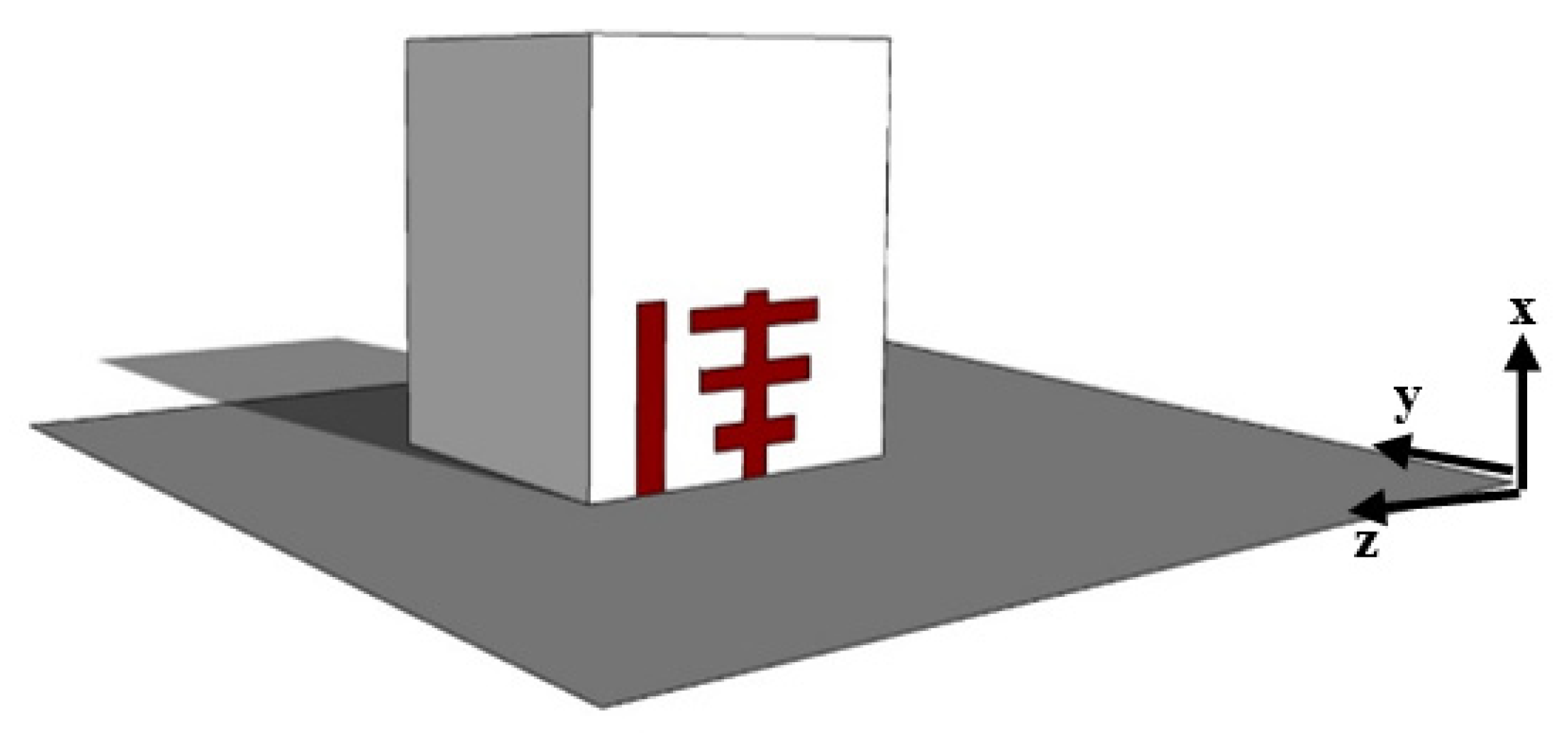
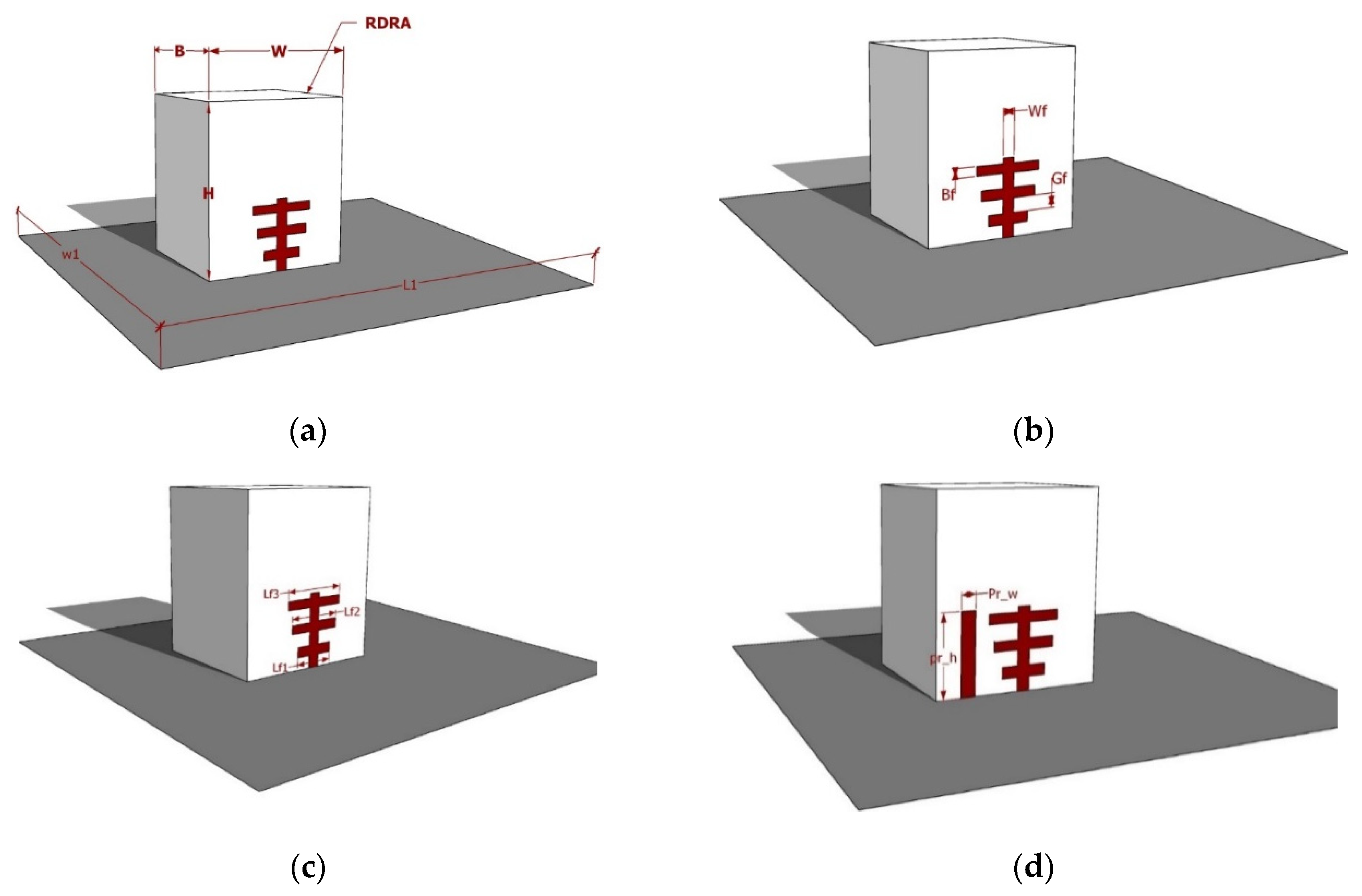


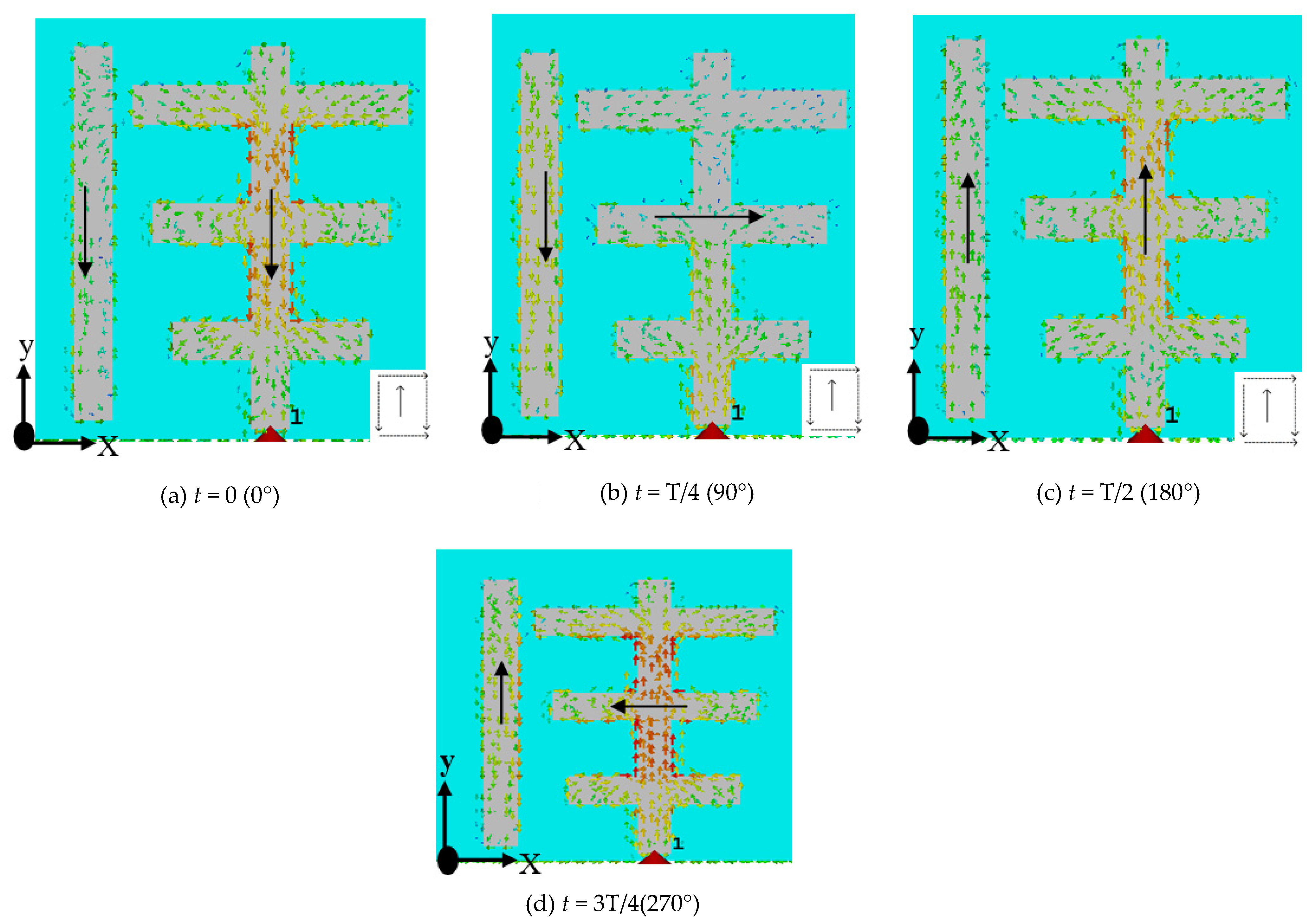

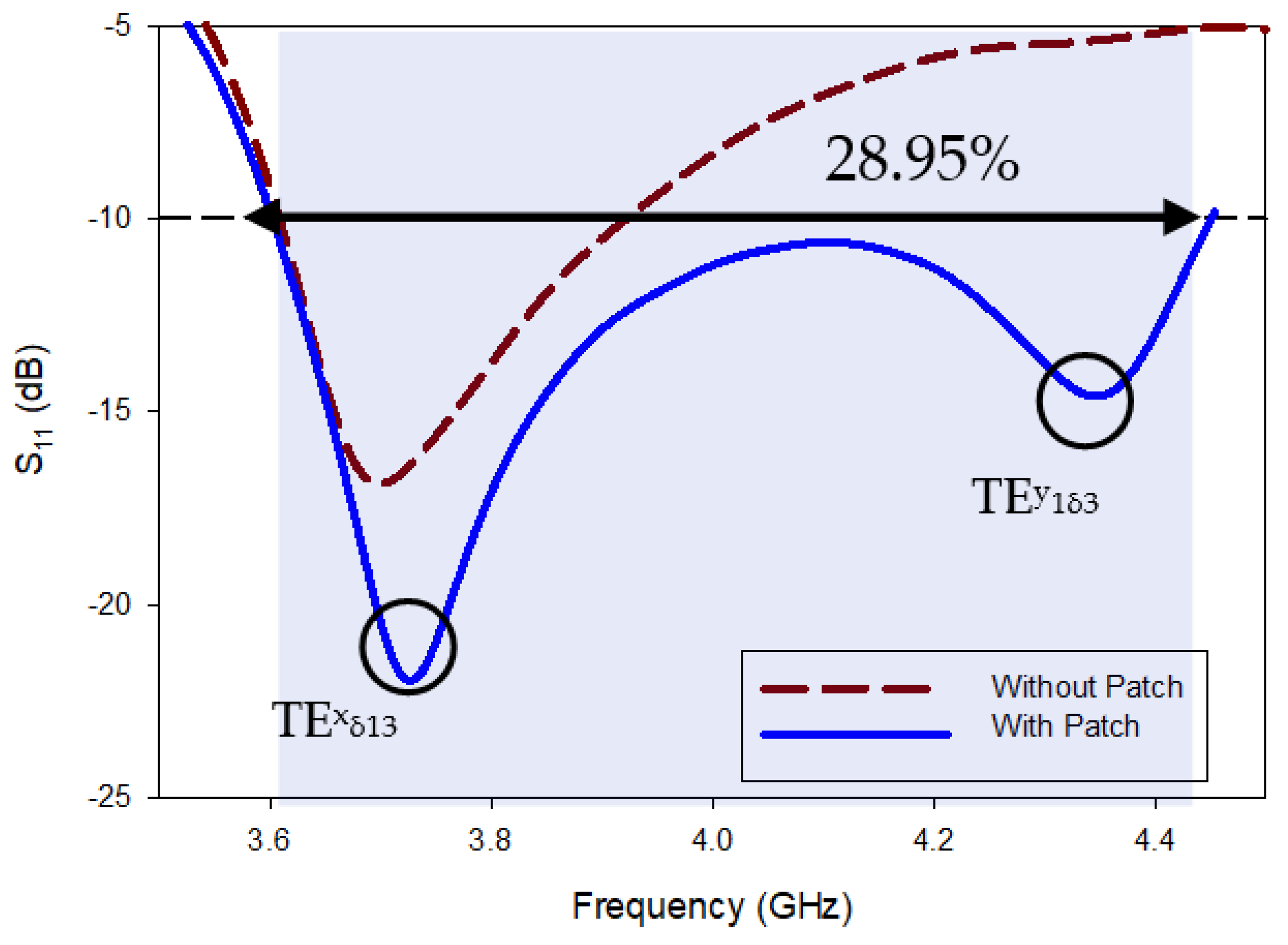
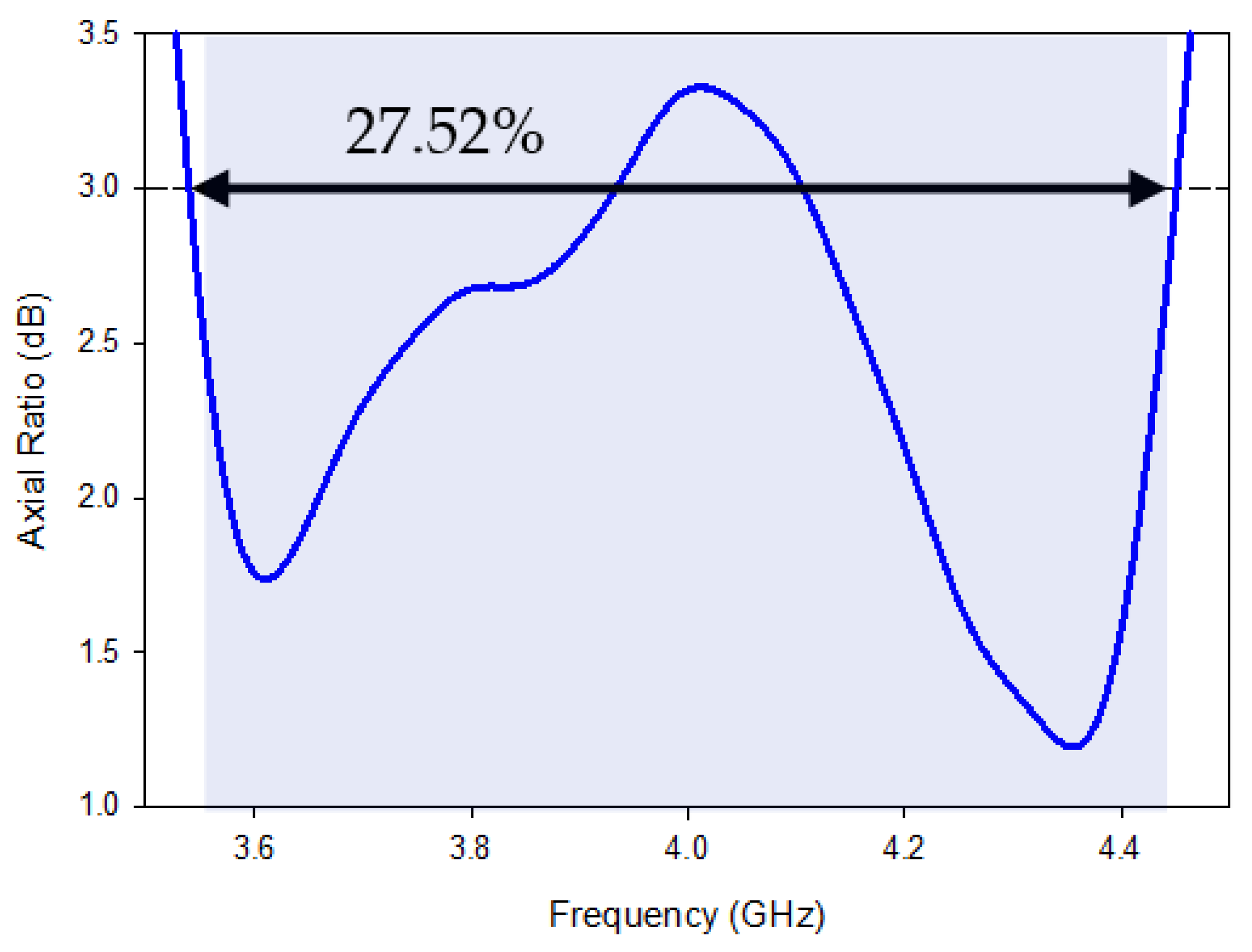
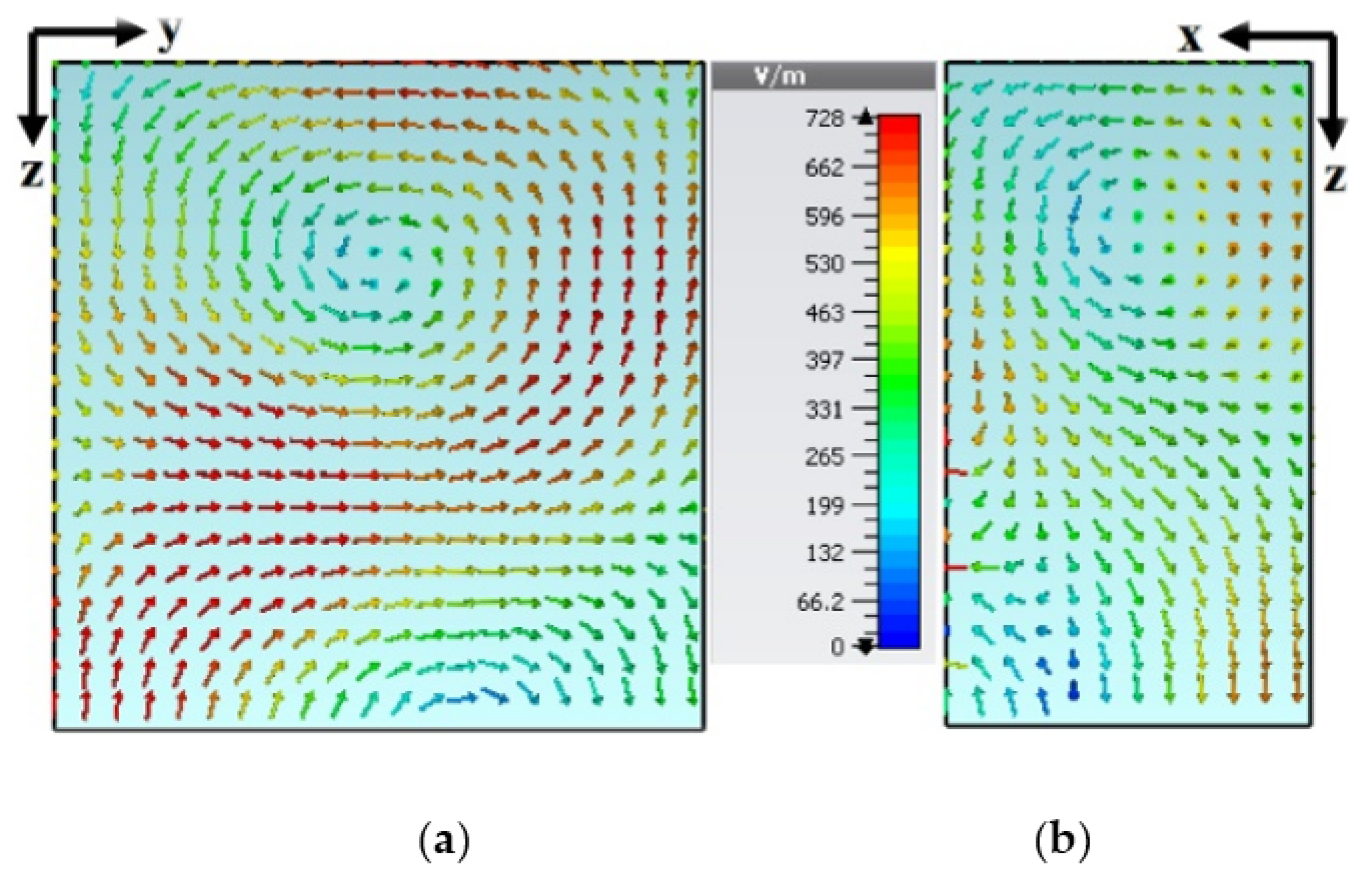
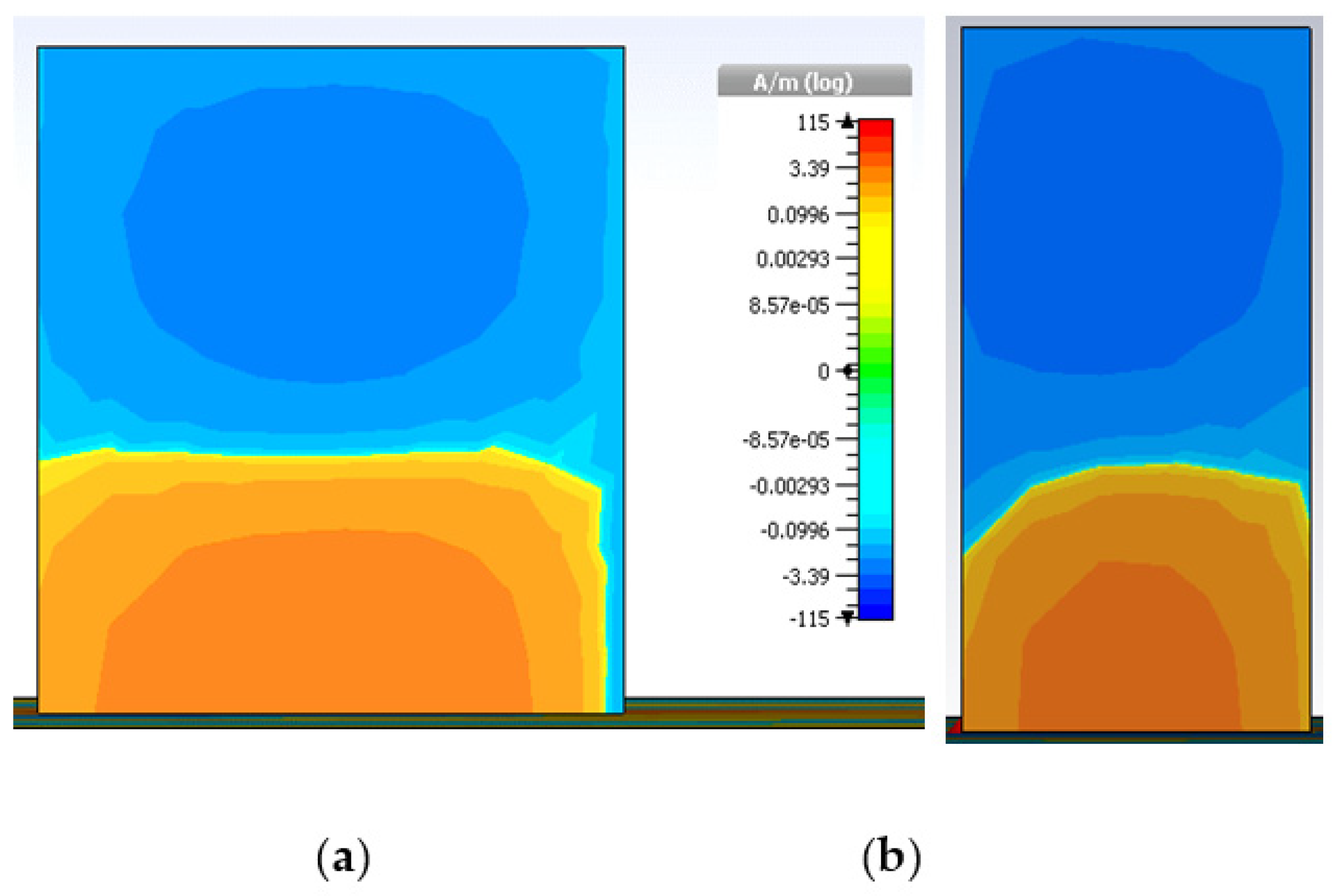
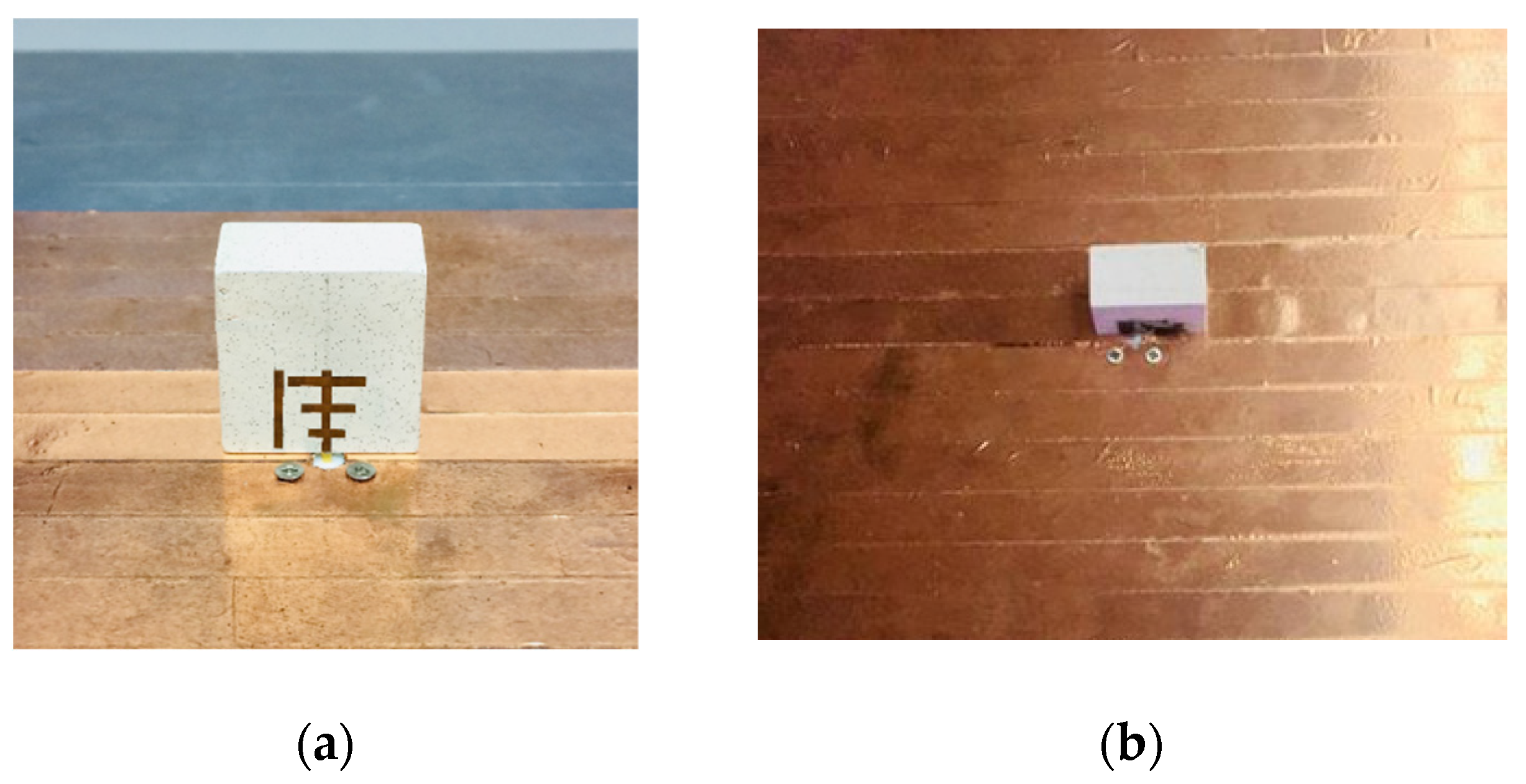
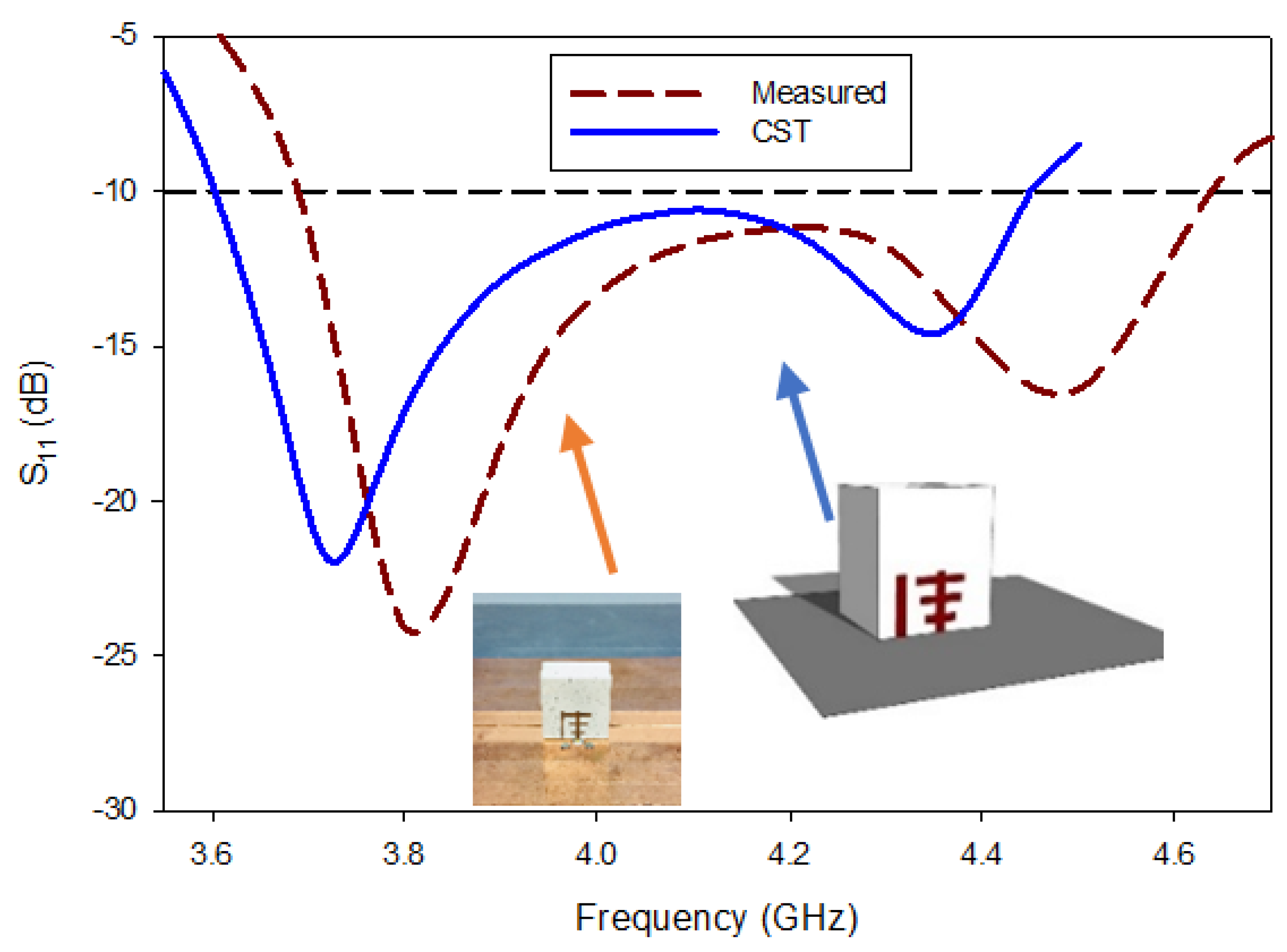
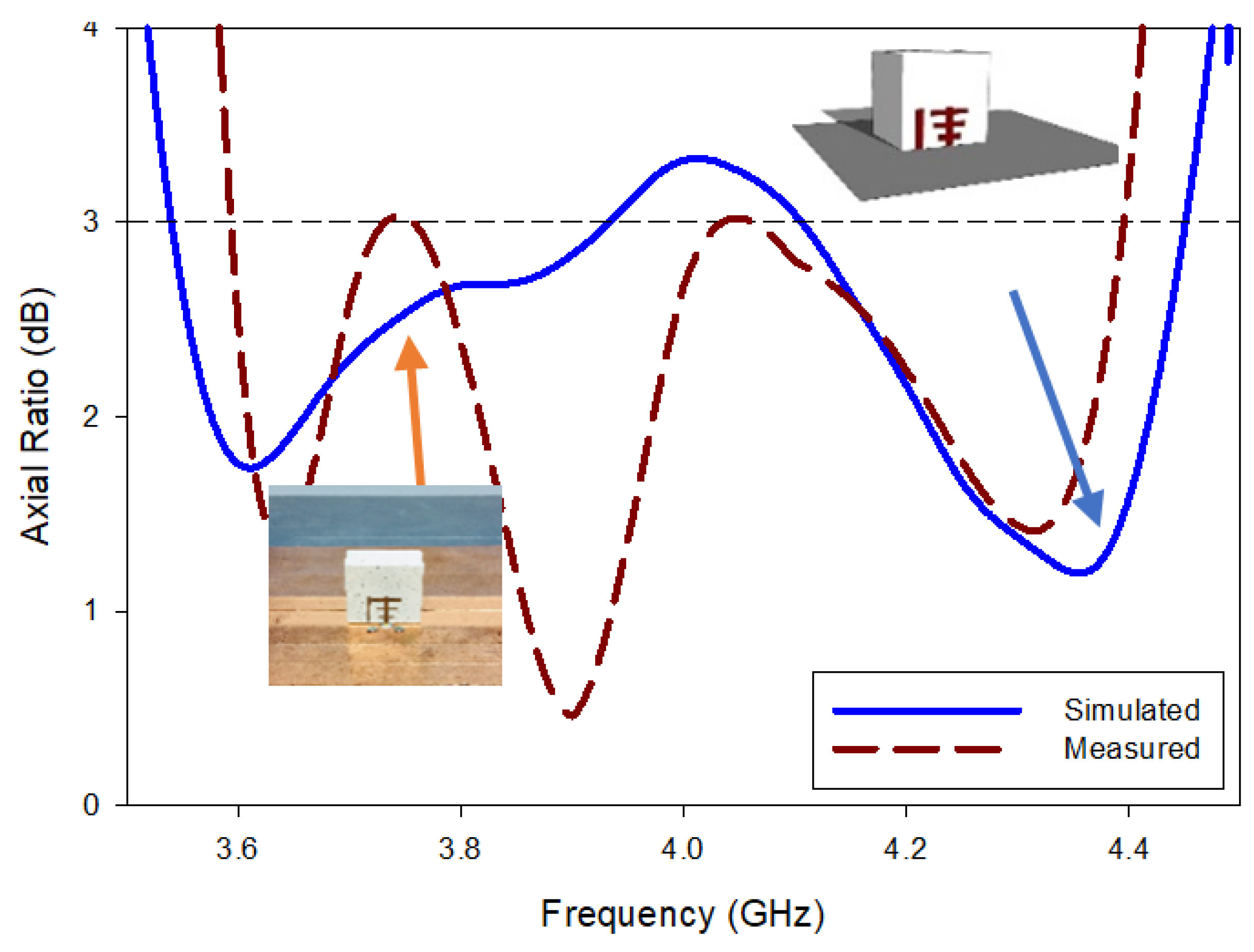
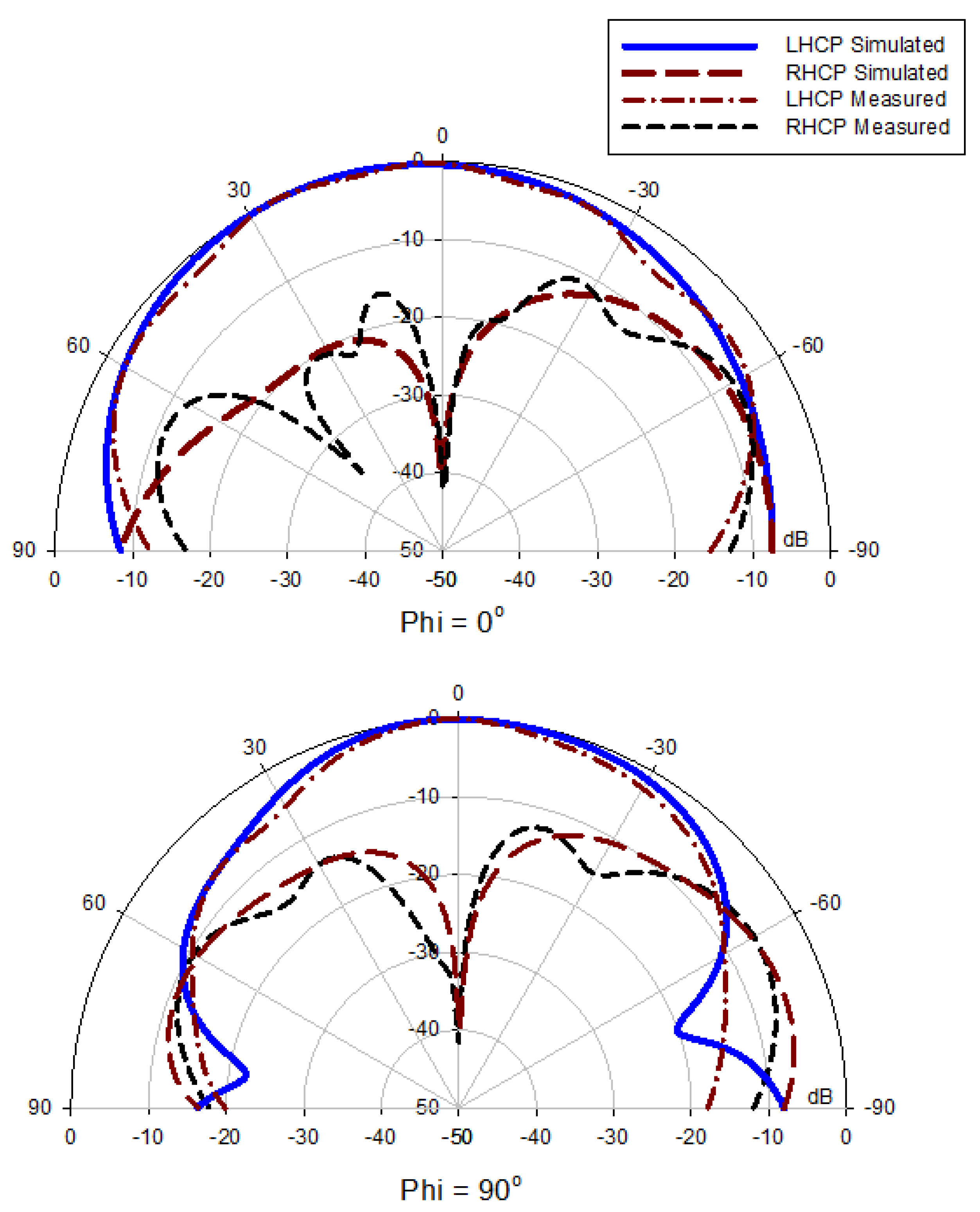
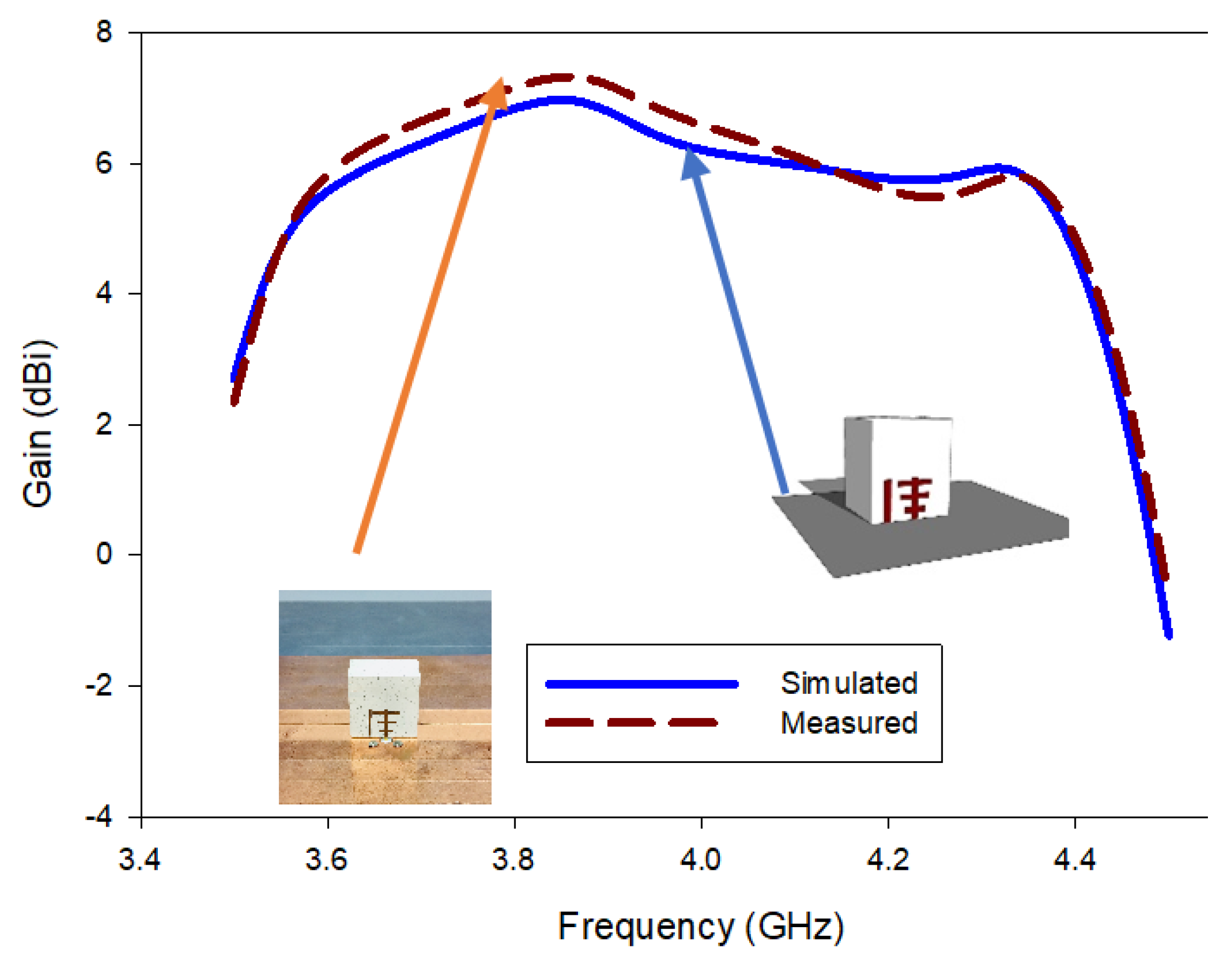
| Element. | Parameter | Dimension (mm) |
|---|---|---|
| PEC Ground Plane | L1, W1 | 35, 35 |
| RDRA | H, W, B | 26.1, 14.3, 25.4 |
| Yagi-Uda Feed | Wf, Bf, Gf, Lf1, Lf2, Lf3 | 1, 1, 2, 3, 5, 7 |
| Parasitic Strip | Pr_h, Pr_w | 11.75, 1.00 |
| Resonant Modes | Fabricated Resonant Frequency | Simulated Resonant Frequency (CST) | Anticipated Resonant Frequency DWM |
|---|---|---|---|
| fMEA (GHz) | fCST (GHz) | fDWM (GHz) | |
| TExδ13 | 3.8 | 3.73 | 3.89 |
| TEy1δ3 | 4.5 | 4.46 | 4.53 |
| CST | Frequency Range (S11) (GHz) | Return Loss (%) | Frequency Range (3 dB) (GHz) | Axial Ratio BW (%) | Gain (dBic) |
|---|---|---|---|---|---|
| 3.6–4.45 | ~28.95 | 3.59–4.40 | 27.52 | 6.64 | |
| Measured | 3.71–4.62 | ~29.74 | 3.59–3.44 | 28.01 | 6.50 |
| Ref | Feeding Mechanism | Wideband Mechanism | Impedance BW GHz,(%) | Overlapping BW % | Gain Max (dBi) | Structure |
|---|---|---|---|---|---|---|
| [14] | Singly fed microstrip, coupled cross slot | Square DRA + 4 parasitic vertical plates | 2.2–3.6 (46.9) | 49.5 | 4.7 | Complicated |
| [4] | Flat surface strip | RDRA + parasitic patch | 2.95–3.65 (13) | 6 | 5 | Simple |
| [8] | Flat surface strip | CDRA + Parasitic patch | 2.31–2.4 (11.5) | 3 | 4.02 | Simple |
| [15] | Coaxial probe feed | RDRA (cutting edge) + floating parasitic strip | 6.57–12.18 (59.8) | 10.6 | 4.86 | Simple |
| [20] | Cross slot | RDRD + multilayer | 9.5–12.5 (21) | 9.5 | 11 | Complicated |
| Proposed work | Singly fed flat surface strip | RDRA + parasitic patch | 3.6–4.45 (29.74) | 28.01 | 6.5 | Simple |
Publisher’s Note: MDPI stays neutral with regard to jurisdictional claims in published maps and institutional affiliations. |
© 2022 by the authors. Licensee MDPI, Basel, Switzerland. This article is an open access article distributed under the terms and conditions of the Creative Commons Attribution (CC BY) license (https://creativecommons.org/licenses/by/4.0/).
Share and Cite
Bari, I.; Iqbal, J.; Ali, H.; Rauf, A.; Bilal, M.; Jan, N.; Illahi, U.; Arif, M.; Khan, M.A.; Ghoniem, R.M. Bandwidth Enhancement and Generation of CP of Yagi-Uda-Shape Feed on a Rectangular DRA for 5G Applications. Micromachines 2022, 13, 1913. https://doi.org/10.3390/mi13111913
Bari I, Iqbal J, Ali H, Rauf A, Bilal M, Jan N, Illahi U, Arif M, Khan MA, Ghoniem RM. Bandwidth Enhancement and Generation of CP of Yagi-Uda-Shape Feed on a Rectangular DRA for 5G Applications. Micromachines. 2022; 13(11):1913. https://doi.org/10.3390/mi13111913
Chicago/Turabian StyleBari, Inam, Javed Iqbal, Haider Ali, Abdul Rauf, Muhammad Bilal, Naveed Jan, Usman Illahi, Muhammad Arif, Muhammad Amir Khan, and Rania M. Ghoniem. 2022. "Bandwidth Enhancement and Generation of CP of Yagi-Uda-Shape Feed on a Rectangular DRA for 5G Applications" Micromachines 13, no. 11: 1913. https://doi.org/10.3390/mi13111913
APA StyleBari, I., Iqbal, J., Ali, H., Rauf, A., Bilal, M., Jan, N., Illahi, U., Arif, M., Khan, M. A., & Ghoniem, R. M. (2022). Bandwidth Enhancement and Generation of CP of Yagi-Uda-Shape Feed on a Rectangular DRA for 5G Applications. Micromachines, 13(11), 1913. https://doi.org/10.3390/mi13111913










